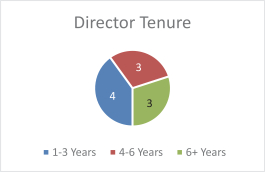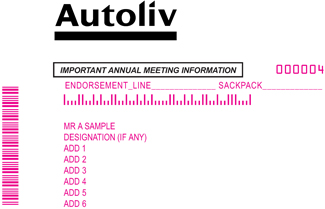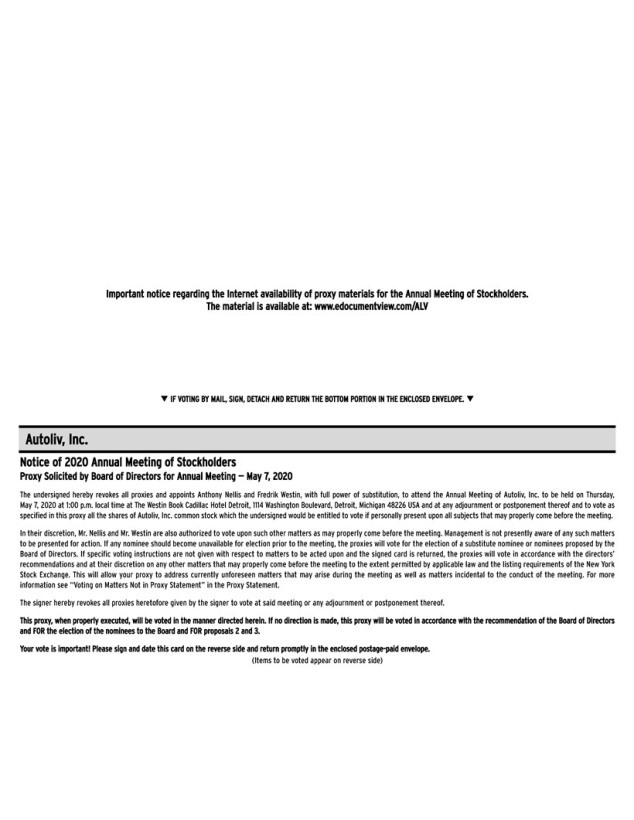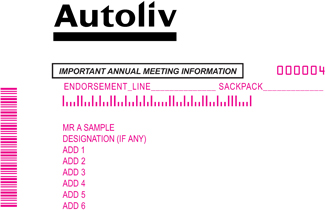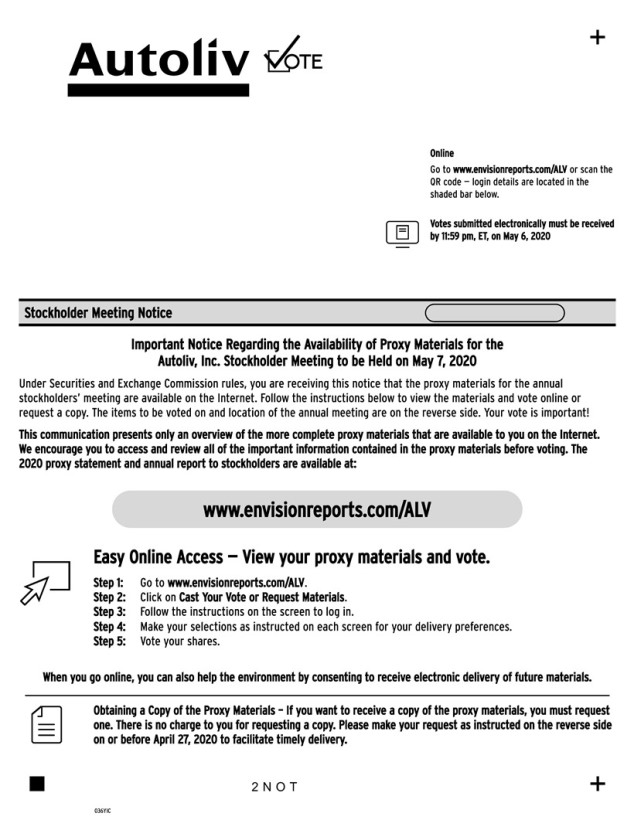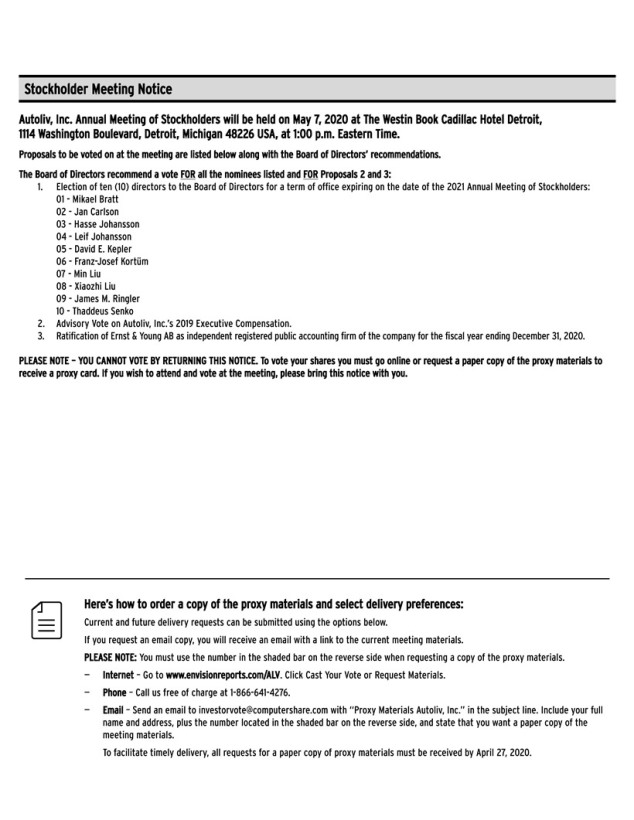The Nominating and Corporate Governance Committee identifies and recommends individuals qualified to serve as members of the Board and assists the Board by reviewing the composition of the Board and its committees, monitoring a process to assess Board effectiveness, and developing and implementing the Company’s Corporate Governance Guidelines. The committee also reviews sustainability and corporate responsibility activities for the Company. The Nominating and Corporate Governance Committee will consider a director candidate nominated by a stockholder provided such nomination is submittednominees for election to the committee withinBoard if timely advance written notice of such nominees is received by the time period set forth in Article II, Section 6 of theBy-Laws. In considering candidates submitted by stockholders, the Nominating and Corporate Governance Committee will take into consideration the needsSecretary of the Board andCompany at its principal executive offices in accordance with the qualificationsBy-Laws, a copy of the candidate. In considering possible candidates for election as a director, the Nominating and Corporate Governance Committee reviews the qualifications and backgrounds of the candidates, including the following: candidate has (i) attained a position of leadership in the candidate’s area of expertise, (ii) business and financial experience relevant to the Company, (iii) demonstrated sound business judgment, (iv) expertise relevantwhich may be obtained by written request to the Company’s linesSecretary or on the Company’s website at www.autoliv.com – About Us – Governance – Certificate and Bylaws. Members of business, (v) independence from management, (vi) the ability to serve on standing committeesthis committee are Messrs. L. Johansson (Chair), Kortüm, and (vii) the ability to serve the interests of all stockholders.Ringler and Dr. X. Liu. The Nominating and Corporate Governance Committee routinely considers board candidates withmet four times in 2019.
The Risk and Compliance Committee was formed as a broad rangespecial committee of educational and professional experiences from a variety of countries. While the Board has no separate formal policy,in June 2011, and was made a standing committee in December 2018, to assist the Board in overseeing the Company’s Corporate Governance Guidelines provide thatcompliance program with respect to (i) compliance with the backgroundslaws and experiencesregulations applicable to the Company’s business and (ii) compliance with the Company’s Standards of Business Conduct and Ethics and related policies by employees, officers, directors and other agents and associates of the director nominees shall reflectCompany that are designed to support lawful and ethical business conduct by the global operationsCompany and its employees and promote a culture of compliance. The Risk and Compliance committee reviews with and receives reports from management on the Company.Company’s risk framework. The current Board consistsRisk and Compliance Committee also oversees risks relevant to our information technology environment and the investigation of directors whoany alleged noncompliance with law or the Company’s compliance programs policies or procedures that is reported to the Risk and Compliance Committee (except any relating to financial compliance, which are citizensoverseen by the Audit Committee). Members of or reside in multiple countries includingthis committee are Messrs. Kepler (Chair), H. Johansson, and Senko. The Risk and Compliance Committee works closely with the U.S., Sweden, Japan, China and Germany and directors with a wide rangeother committees of management, operating, finance and engineering skills. The Nominating and Corporate Governance Committee, the Board and the Company place a high priority on diversity, with a particular emphasis on seeking out individuals with a wide variety of management, operating, engineering, technology and finance experiences and skills as well as individuals from the Company’s different operating regions. The Nominating and Corporate Governance Committee continues to look for opportunities to further progress its diversity initiatives.
The Nominating and Corporate Governance Committee identifies potential director nominees by asking current directors and executive officers to notify the committee if they become aware of persons meeting the criteria described above. The Nominating and Corporate Governance Committeehas three members that also from time to time, engages firms that specialize in identifying director candidates. As described above, the Nominating and Corporate Governance Committee will also consider candidates recommended by stockholders. Once a person has been identified by the Nominating and Corporate Governance Committee as a potential candidate, the committee collects and reviews publicly available information regarding the person to determine whether further consideration should be given to the person’s candidacy. If the Nominating and Corporate Governance Committee determines that the candidate warrants further consideration, the chairman of the committee or another member of the committee will contact such person. Generally, if the person expresses a willingness to be considered to serve on the Board,Audit Committee, one of which serves as the NominatingChair. The Risk and Corporate GovernanceCompliance Committee will request information from the candidate, review the candidate’s accomplishments and qualificationsmet four times in light2019.
Audit Committee Report
The Audit Committee of the qualifications of any individuals the committee might be considering, and conduct one or more interviews with the candidate. In certain instances, committee members may contact one or more references provided by the candidate or may contact other membersBoard is responsible for providing independent, objective oversight of the business community or other persons that may have first-hand knowledge of the candidate’s accomplishments. The NominatingCompany’s accounting functions and Corporate Governance Committee’s evaluation process does not vary based on whether a candidate is recommended by a stockholder.internal controls.
The Nominating and Corporate Governance Committee can be contacted as follows:
The Nominating and Corporate Governance Committee
c/o Group Vice President Legal Affairs
Autoliv, Inc., Box 70381
SE-107 24 Stockholm, Sweden
Phone: +46 8 587 20 600
Fax: +46 8 587 20 633
E-mail: legalaffairs@autoliv.com
- 15 -
Communications with the committee are not screened and can be made anonymously. The Chairman of the committee receives all such communications after it has been determined that the content represents a message to the committee.
George A. Lorch, Chairman
Leif Johansson
Franz-Josef Kortüm
Xiaozhi Liu
James M. Ringler
Compensation Committee Duties, Procedures and Policies
The CompensationAudit Committee acts pursuant to a written charter. The committee’s current charter is posted on the Company’s website at www.autoliv.com – About Us – Governance – Board of Directors – Committees and can also be obtained free of charge in print by request from the Company using the contact information below. Each member of the CompensationAudit Committee has been determined by the Board to beis “independent” as defined in, and is qualified to serve on the committee pursuant to, the rules of the NYSE, the Sarbanes-Oxley Act of 2002, and the rules and regulations promulgated by the SEC.
The Compensation Committee is responsible for (i) reviewing annually the Company’s executive compensation plans in light of the Company’s goals and objectives of such plans; (ii) evaluating annually the performance of the Chief Executive Officer in light of the goals and objectives of the Company’s executive compensation plans and, together with the other independent directors, determining and approving the Chief Executive Officer’s compensation level based on this evaluation; (iii) evaluating annually the performance of the other executive officers of the Company in light of the goals and objectives of the Company’s executive compensation plans, and setting the compensation of such other executive officers based on this evaluation; (iv) evaluating annually the appropriate level of compensation for Board and committee service bynon-employee directors; (v) reviewing and approving any severance or termination arrangements to be made with any executive officer of the Company; (vi) reviewing perquisites or other personal benefits to the Company’s executive officers and directors and recommending any changes to the Board; (vii) reviewing and discussing with management the CD&A, beginning on page 22 of this Proxy Statement, and based on that review and discussion, recommending to the Board that the CD&A be included in the Company’s annual proxy statement or annual report on Form10-K; (viii) preparing the Compensation Committee Report for inclusion in the annual proxy statement or annual report on Form10-K; and (ix) reviewing the description of the Compensation Committee’s process and procedures for the consideration and determination of executive officer and director compensation to be included in the Company’s annual proxy statement or annual report on Form10-K.
The Compensation Committee from time to time uses independent compensation consultants to provide advice and ongoing recommendations regarding executive compensation. In June 2015, the Compensation Committee engaged Frederic W. Cook & Co., Inc. (“FW Cook”) as its new independent advisor. FW Cook reported directly to the Compensation Committee with respect to executive compensation matters. In 2016, the Company also engaged Towers Watson as a compensation consultant. For additional information regarding the role of each of these compensation consultants and the scope of their engagement, see page 31 of this Proxy Statement.
The Compensation Committee considered the independence of Towers Watson and FW Cook in light of the SEC rules and NYSE listing standards. The Compensation Committee also received a letter from each of Towers Watson and FW Cook addressing their independence. The Compensation Committee considered the following factors in determining the independence of the compensation consultants: (i) other services provided to the Company by each of Towers Watson and FW Cook; (ii) fees paid by the Company as a percentage of each consultant’s total revenue; (iii) policies or procedures maintained by Towers Watson and FW Cook that are designed to prevent a conflict of interest; (iv) any business or personal relationships between the individual consultants involved in the engagement and any member of the Compensation Committee; (v) any Company stock owned by the individual consultants involved in the engagement; and (vi) any business or personal relationships between the Company’s executive officers and Towers Watson or FW Cook or the individual consultants involved in the engagement. The Compensation Committee discussed these independence factors and concluded that the work of Towers Watson and FW Cook did not raise any conflicts of interest.
- 16 -
The Compensation Committee may form subcommittees for any purpose it deems appropriate and may delegate to any subcommittee such power and authority as it deems appropriate provided that no subcommittee shall consist of fewer than two members and that the Compensation Committee shall not delegate any power or authority required by any law, regulation or listing standard to be exercised by the Compensation Committee as a whole. Under the Company’s 1997 Stock Incentive Plan, as amended and restated (the “1997 Plan”), the Compensation Committee may, to the extent that any such action will not prevent the 1997 Plan from complying with applicable rules and regulations, delegate any of its authority thereunder to such persons as it deems appropriate. In addition, the Compensation Committee has delegated the authority to determine certain grants under the Company’s long-term incentive plan to the CEO, subject to established grant limits. The Compensation Committee reviews the compensation levels set by the CEO under the long-term incentive program.
The Group Vice President for Human Resources of the Company generally acts as Secretary of the Compensation Committee.
The Compensation Committee can be contacted as follows:
The Compensation Committee
c/o Group Vice President Legal Affairs
Autoliv, Inc., Box 70381
SE-107 24 Stockholm, Sweden
Phone: +46 8 587 20 600
Fax: +46 8 587 20 633
E-mail: legalaffairs@autoliv.com
Communications with the committee are not screened and can be made anonymously. The Chairman of the committee receives all such communications after it has been determined that the content represents a message to the committee.
Compensation Committee Interlocks and Insider Participation
The Compensation Committee is comprised exclusively of directors who have never been employed by the Company and who are “independent” as defined in the applicable rules of the NYSE, the Sarbanes-Oxley Act of 2002, as amended, and the rules and regulations promulgated by the SEC. No executive officerEach member is financially literate and possesses accounting or related financial management expertise, and Mr. Senko has been determined by the Board to qualify as an “audit committee financial expert” as defined by the SEC. Pursuant to the charter of the Company served as aAudit Committee, no member of the compensationAudit Committee may serve on the audit committee of another entity, onemore than two other public companies unless the Board determines that such simultaneous service would not impair the ability of whose executive officers servedsuch Audit Committee member to effectively serve on the Audit Committee. The Audit Committee reviews the Company’s Compensation Committee. No executive officerfinancial reporting process on behalf of the Company served as a director of another entity, one of whose executive officers either served onBoard. In fulfilling its responsibilities, the compensation committee of such entity or served as a director of the Company.
Compensation Committee Report1
The CompensationAudit Committee has reviewed and discussed with management the Company’s Compensation Discussion and Analysis and, based on such review and discussions, has recommended to the Board that the Compensation Discussion and Analysis be included in this Proxy Statement and incorporated by reference into the Company’s 2016 Annual Report on Form10-K.
James M. Ringler, Chairman
Aicha Evans
Leif Johansson
Xiaozhi Liu
George A. Lorch
The Swedish Corporate Governance Code
Swedish companies with shares admitted to trading on a regulated market in Sweden, including the NASDAQ Stockholm, are subject to the Swedish Corporate Governance Code (the “Swedish Code”). This is a codification of best practices for Swedish listed companies based on Swedish practices and circumstances. The Swedish Code follows a “comply or disclose” approach; its recommendations are not binding on companies but if
1 | The material in this report is not soliciting material, is not deemed filed with the SEC and is not incorporated by reference in any filing of the Company under the Securities Act of 1933, as amended, whether made on, before, or after the date of this Proxy Statement and irrespective of any general incorporation language in such filing. |
- 17 -
its recommendations are not complied with, the deviation must be explained. Anon-Swedish company listed in Sweden can elect to either apply the Swedish Code or the corresponding local rules and codes where the company’s shares have their primary listing or where the company is headquartered. As a Delaware corporation with its primary listing on the NYSE, the Company has elected to apply U.S. corporate governance rules and standards. These U.S. rules and standards are describedaudited financial statements contained in the “Corporate Governance” section beginning on page 88 of the Company’s Annual Report for the fiscal year ended December 31, 2016. In addition, this Proxy Statement provides detailed information on various subjects covered by the Swedish Code.
Forward-Looking Statements
This Proxy Statement contains statements that are not historical facts but rather forward-looking statements within the meaning of the Private Securities Litigation Reform Act of 1995. Such forward-looking statements include those that address activities, events or developments that the Company or its management believes or anticipates may occur in the future. All forward-looking statements including, without limitation, statements regarding the expected consummation of the joint venture with Volvo Cars, management’s examination of historical operating trends and data as well as estimates of future sales, operating margin, cash flow, effective tax rate or other future operating performance or financial results, are based upon our current expectations, various assumptions and/or data available from third parties. Our expectations and assumptions are expressed in good faith and we believe there is a reasonable basis for them. However, there can be no assurance that such forward-looking statements will materialize or prove to be correct as forward-looking statements are inherently subject to known and unknown risks, uncertainties and other factors which may cause actual future results, performance or achievements to differ materially from the future results, performance or achievements expressed in or implied by such forward-looking statements.
In some cases, you can identify these statements by forward-looking words such as “estimates,” “expects,” “anticipates,” “projects,” “plans,” “intends,” “believes,” “may,” “likely,” “might,” “would,” “should,” “could,” or the negative of these terms and other comparable terminology, although not all forward-looking statements contain such words.
Because these forward-looking statements involve risks and uncertainties, the outcome could differ materially from those set out in the forward-looking statements for a variety of reasons, including without limitation: changes in light vehicle production; fluctuation in vehicle production schedules for which the Company is a supplier; changes in and the successful execution of our capacity alignment, restructuring and cost reduction initiatives and the market reaction thereto; changes in general industry and market conditions or regional growth or decline; loss of business from increased competition; higher raw material, fuel and energy costs; changes in consumer and customer preferences for end products; customer losses; changes in regulatory conditions; customer bankruptcies; consolidations or restructuring or divestiture of customer brands; unfavorable fluctuations in currencies or interest rates among the various jurisdictions in which we operate; component shortages; costs or difficulties related to the integration of any new or acquired businesses and technologies; continued uncertainty in pricing negotiations with customers; successful integration of acquisitions and operations of joint ventures; our ability to be awarded new business; product liability, warranty and recall claims and investigations and other litigation and customer reactions thereto; higher expenses for our pension and other postretirement benefits including higher funding requirements for our pension plans; work stoppages or other labor issues; possible adverse results of pending or future litigation or infringement claims; our ability to protect our intellectual property rights; negative impacts of antitrust investigations or other governmental investigations and associated litigation relating to the conduct of our business; tax assessments by governmental authorities and changes in our effective tax rate; dependence on key personnel; legislative or regulatory changes impacting or limiting our business; political conditions; dependence on and relationships with customers and suppliers; and other risks and uncertainties identified in Item 1A “Risk Factors” in our Annual Report on Form10-K for the fiscal year ended December 31, 20162019 with the Company’s management and independent registered public accounting firm. The Company’s management is responsible for the financial statements and the reporting process, including the system of internal controls. The independent registered public accounting firm is responsible for expressing an opinion on the conformity of those audited financial statements with accounting principles generally accepted in the “Management’s DiscussionU.S.
The Audit Committee discussed with the independent registered public accounting firm the matters required to be discussed under the applicable auditing standards of the Public Company Accounting Oversight Board (“PCAOB”). In addition, the Company’s independent registered public accounting firm provided to the Audit Committee the written disclosures required by the PCAOB’s applicable requirements regarding the independent registered public accounting firm’s communications with the Audit Committee concerning independence. The Audit Committee has discussed with the independent registered public accounting firm the independent registered public
- 16 -




